
Goats in the Sailor's Diet: 1 2 3 4 <<First
Goats in Sailor's Diets During the Golden Age of Piracy, Page 4
Goats as Food: Survival
Being trapped on a deserted island may sound positively idyllic to some, but it was an uncertain and harrowing sentence for the survivor. In our modern world of ubiquitous connection, it's hard to imagine the horror of this existence during the golden age of piracy. As Edward Leslie explains in his accounts of various castaways throughout history, "The task of the survivor is to keep himself alive until 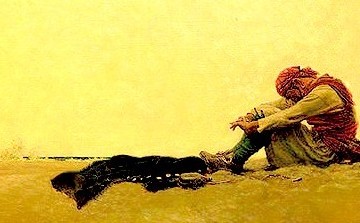
Artist: Howard Pyle, Marooned (1901)
he is rescued. For the maroon this means locating reliable sources of water and food and securing the means to build a fire. The list is deceptively simple"1.
Being abandoned on an uninhabited piece of land was such a curse that one of the pirate's punishments for breaching their articles was marooning. Captain Johnson explains in the account of Bartholomew Roberts that marooning "was a Barbarous Custom of putting the Offender on Shore, on Some desolate or uninhabited Cape or Island, with a Gun, a few Shot, a Bottle of Water, and a Bottle of Powder, to subsist with, or starve."2 In his second book on the lives of the pirates, Johnson reveals that John Auger's mutinous crew debated "killing Richard Turnley, but the majority carried it for marooning, that he might be starved, and die like a dog, as they called it."3
If the maroon or castaway were lucky, he would find himself on an island that satisfied two or Mr. 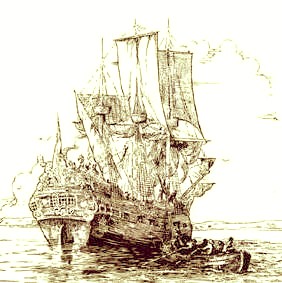
Artist: John Alcott
William Dampier's ship HMS Roebuck (1690)
Leslie's three basic requirements: one which contained good and fresh water. Several of the survivors of being castaway found themselves in place that afforded them goats.
When Edward England's crew decided that the good captain was not representing their interests well, "with the Company's Force, he was soon abdicated or pulled out of his Government, and marooned with three more on the Island of Mauritius. An Island indeed, not to be complained of, had they accumulated any Wealth by their Villanies that would have afforded some future comfortable Prospect, for it abounds with Fish, Deer, Hogs and other Flesh."4 As we have already seen, the 'other Flesh' included goats.
In 1701, Buccaneer William Dampier's ship the Roebuck "foundered through perfect age at the Island of Ascension"5. The ship sank "in the common anchoring spot in Clarence Bay to the northwest of the island. Some sixty men survived for two months until they were rescued."6 Although this said little for Dampier's skill as a captain, resulting his being found not to be "a fit person to command a King's ship" during the resulting court-martial in England7, it does speak to the usefulness of goats in survival, given what we learned about Ascension.
Goats as Food: Survival - Juan Fernandez Island
Juan Fernandez is perhaps most celebrated as being the location of Alexander Selkirk's internment for four years as mentioned. However, there was another captive before Selkirk who, while not reaching Selkirk's level of notoriety, was still left stranded on the island nearly as long as Selkirk had been. He is only referred to as 'Will', the Miskito Indian (a Central American tribe). He had accidentally been left behind by Captain Sharp's buccaneers following their stop during Christmas and New Years in 1680. Will had been in the mountains hunting goats when the buccaneers beat a hasty retreat to avoid capture by the Spanish in January.8
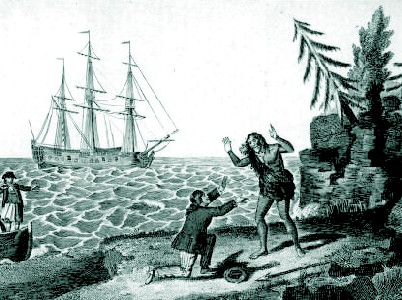
Artist: Hubert Gravelot
Captain Dampier and the Miskito Indian on Juan Fernandez, from A new,
complete, and universal collection of authentic and entertaining
voyages and travels to all the various parts of the world. (1794)
When Dampier returned to the island in March of 1684, he was curious about the fate of Will. He explains that they "got out our Canoa, and went ashore to see for a Moskito Indian, whom we left here when we were chased hence by three Spanish Ships in the Year 1681"9. Dampier reported that during his three years of isolation on Juan Fernandez, Will "got such Provision as the Island afforded; either Goats or Fish. He told us that at first he was forced to eat Seal, which is very ordinary Meat, before he had made hooks [by cutting his gun barrel using his knife, which he had serrated] but afterwards he never killed any Seals but to make Lines, cutting their Skins into Thongs."10
Alexander Selkirk was left there by Thomas Stradling, the Captain of the Cinque Ports a little more than twenty years later in September of 1704. The Cinque Ports had accompanied William Dampier's ship the St George until Stradling became doubtful of Dampier's competence following a series of decisions Dampier made that resulted in their missing out on plunder.
Taking leave of Dampier, the Cinque Ports stopped at Juan Fernandez, where Stradling intended to make a brief visit to refit his ship. While there, Selkirk had a dream that the Cinque Ports would sink and stated that he would rather be left on the island than go ahead on the journey if the ship were not properly repaired.11 Selkirk was no sooner set ashore than he regretted his decision, but Stradling would not take him back on board. (Strandling's crew were eventually captured by the Spanish and imprisoned, so Selkirk may have made out better than he thought.)
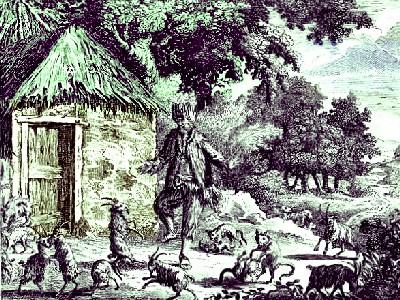
Alexander Selkirk Dancing with Goats and Cats, From A Universal
Collection of Authentic And Entertaining Voyages and Travels, p. 86 (1765)
In February of 1709, Woodes Rogers privateering fleet landed at Juan Fernandez to tend to men sick with scurvy. There they found Selkirk, clad in "a Coat and Cap of Goat-Skins, which he stich'd together with little Thongs of the same, that he cut with his Knife. He had no other needle but a Nail"12. Edward Cooke adds that he also had a pair of goat's skin breeches.13
As it turned out, the wild goats of Juan Fernandez had been very good to Selkirk in one way or another. Woodes Rogers reports:
The Rats gnaw’d on his Feet and Clothes while asleep, which oblig’d him to cherish the [wild] Cats with his Goats-flesh; by which many of them became so tame, that they would lie about him in hundreds, and soon deliver’d him from the Rats. He likewise tam’d some [goat's] Kids, and to divert himself would now and then sing and dance with them and his Cats; so that by the Care of Providence and Vigour of his Youth, being now but about 30 years old, he came at last to conquer all the In conveniences of his Solitude, and to be very easy.14
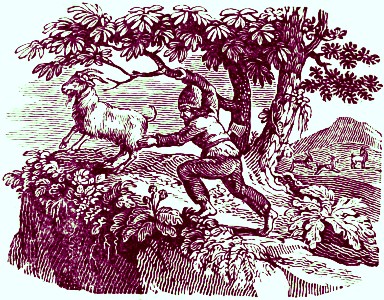
Selkirk Catching a Goat on a Cliff, from The Life and Adventures of
Alexander Selkirk by John Howell (1841)
Rogers also notes that Selkirk built two huts and "cover’d them with long Grass, and lin’d them with the Skins of Goats, which he kill’d with his Gun as he wanted, so long as his Powder lasted"15. When the powder ran out, he trained himself to catch them by hand - his feet hardening as he traveled over the rocky ground of the island and his agility improving as he chased his cloven-footed prey. There was a downside to becoming as sure-footed as a goat, however.
[Selkirk] told us that his Agility in pursuing a Goat had once like to have cost him his Life; he pursu’d it with so much Eagerness that he catch’d hold of it on the brink of a Precipice, of which he was not aware, the Bushes having hid it from him; so that he fell with the Goat down the said Precipice a great height, and was so stun’d and Bruis’d with the Fall, that he narrowly escap’d with his Life, and when he came to his Senses, found the Goat dead under him. He lay there about 24 hours, and was scarce able to crawl to his Hutt, which was about a mile distant, or to stir abroad again for ten days.16
While chasing the goat was almost Selkirk's undoing, it should be noted that this goat broke his fall. For the most part, goats proved to be a crucial part to the survival - both physical and mental - of Alexander Selkirk.
1 Edward E.Leslie, Desperate Journeys, Abandoned Souls, p. 21; 2 Captain Charles Johnson, A general history of the pirates, 3rd Edition, p. 230; 3 Captain Charles Johnson, The History of the Pirates, p. 234; 4 Johnson, p. 124; 5 John Masefield, Introduction, Dampier's Voyages, p. 5; 6 Ascencion Island, wikipedia, gathered 4/6/13; 7 Masefield, Ibid.; 8 Diana Souhami, Selkirk's Island, p. 40; 9 William Dampier, Memoirs of a Buccaneer, Dampier’s New Voyage Round the World -1697-, p. 65; 10 Dampier, p. 67; 11 John Howell, The LIfe and Adventures of Alexander Selkirk, p.6 & Alexander Selkirk, wikipedia, gathered 4/7/13; 12 Woodes Rogers, A Cruising Voyage Round the World, p. 72; 13 Edward Cooke, A Voyage to the South Sea and Round the World in the Years 1708 to 1711, p. 34; 14 Rogers, p. 72; 15 Ibid.; 16 Ibid.
Goats as Food: Healing the Sick
"Goat’s flesh has all the bad properties of beef; it is an indigestible, more flatulent and engenders acid eructations [belching] and cholera; such as has a fragrant smell, is firm, and sweet to the
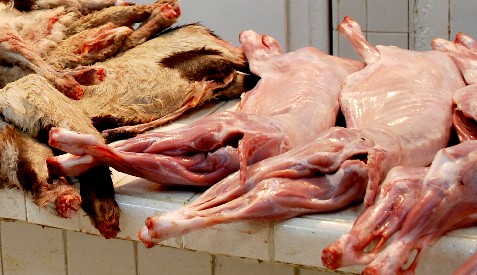
Photographer: Alejandro Linares Garcia,
Dressed and Partially-Dressed Goat's Meat
taste, have a bad smell, and are hard, such are particularly bad, and especially if very fresh; it is best in summer and worst in autumn." (Hippocrates, On Regimen in Acute Diseases, p. 41)
The diet of a patient was a matter considered by many surgeons and physicians to be important to recovery. Despite the fact that the still-revered ancient physician Hippocrates had spoken so harshly of the properties of goat's meat, it was widely considered a good food for patients recovering from various health problems during the golden age of piracy. Sea physician Thomas Aubrey advised that for a patient recovering from an 'intermitting Fever', "the Diet [should] be only Broth of Chickens, Goats-flesh, thick Water-gruels, or such like 'till the Fever hath entirely quitted the Patient, and by that Means you may expect to perfect the Cure with less Difficulty, and also there will be less Danger of a Relapse."1
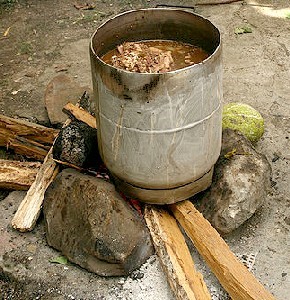
Photographer: Desiree Lowe
Jamaican Goat Soup - Called 'Mannish Water'
Aubrey seems to have been a particular fan of goat in the diet of the ill. When treating gonorrhea, he recommended that following purging, mercury administration and sweating, the patient should be given "a little Goat’s Broth; they will have two or three very copious Stools, and void each time abundance of filthy, viscid, stinking Jelly; after which, give them to eat of the Goat’s Flesh for Dinner; by this Means they will be perfectly cured"2.
The celebrated French surgeon Ambroise Paré also suggested including goat's meat in a patient's diet. In nursing a man who had received a gunshot wound, Paré recommended "Panada [a gruel with a base of bread crumbs, toast, flour or other grains] made ...with the white fleshy parts of Capons, and Partridge wings minced small, and other rostmete easie of digestion, as Veale, Goate, Pigeon, Partridge, and the like."3
So goat seemed to be widely embraced as a way to nurture a patient back to health. It was particularly cited by a group of familar mariners in one disease.
Goats as Food: Healing the Sick - Scurvy
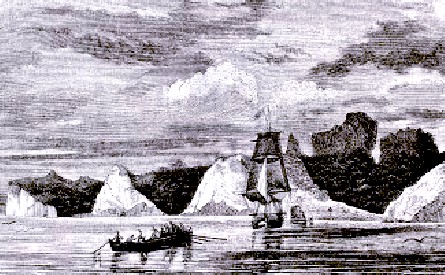
Artist: Louis Le Breton
Juan Fernandez Landing, From Le Magasin Pittoresque (1842)
Several sea authors discuss the use of goats to treat men of scurvy when on Juan Fernandez Island. The first is Dampier, who records that in 1684 his crew "remained at John Fernando’s sixteen Days; our sick Men were ashore all the time, and one of Captain [John] Eaton’s Doctors (for he had four in his Ship) tending and feeding them with Goat and several Herbs, whereof here is plenty growing in the Brooks; and their Diseases were chiefly Scorbutick."4 Today we know that goat's meat would have had no impact on scurvy whatsoever, but during this period in history the source of the illness was wholly unknown and scientific methodology was not well understood, so the cure was uncertain. If the men recovered and goats were a part of the diet that did it, perhaps they held the key!
Woodes Roger's privateers stopped in 1709 with one of his goals being to cure the men sick of scurvy. Dampier being Roger's navigator may or may not have had any bearing on the belief that goat's meat would help repair the sick men's health. The descriptive Roger's explained in his account that tents were
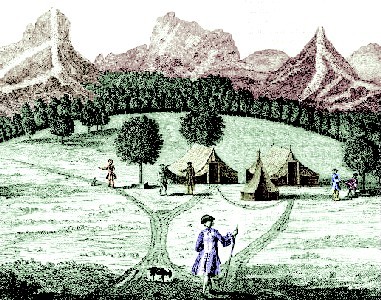
Artist: Richard Walter
Tents on Juan Fernandez, From from Voyage Autour du Monde (1751)
set up on shore for the sick after they had established the island as a safe place to harbor for a while. "The Governour (tho we might have nam’d him the Absolute Monarch of the Islands) for so we call’d Mr. Selkirk, caught us two Goats, which make excellent Broth mix’d with Turnip-Tops and other Greens, for our sick Men, being 21 in all but not above two that we account dangerous; the Dutchess has more Men sick, and in a worse condition than ours."5 Apparently delighted with Selkirk's discovery and role in their recovery, Rogers later notes that he "never fail’d of getting us two or three Goats a day for our sick Men, by which with the help of the Greens and the Goodness of the Air they recover’d very fast of the Scurvy, which was their general Distemper."6
The more taciturn Edward Cooke, captain of the Dutchess simply reported in his book that most of the ill "recover’d with eating of Goats Flesh and fresh Fish, only two dying, which were Edward Wilts, and Christopher Williams."7 Rogers was closer to the mark in this case, however when he credited the 'help of the Greens' which we today know probably contained Vitamin C.
1 Thomas Aubrey, The Sea-Surgeon or the Guinea Man’s Vadé Mecum., p. 44-5; 2 Aubrey, p. 122; 3 Ambroise Paré, The Apologie and Treatise of Ambroise Paré, p. 81; 4 William Dampier, Memoirs of a Buccaneer, Dampier’s New Voyage Round the World -1697-, p. 214; 5 Woodes Rogers, A Cruising Voyage Round the World, p. 74; 6 Rogers, ibid.; 7 Edward Cooke, A Voyage to the South Sea and Round the World in the Years 1708 to 1711, p. 110

